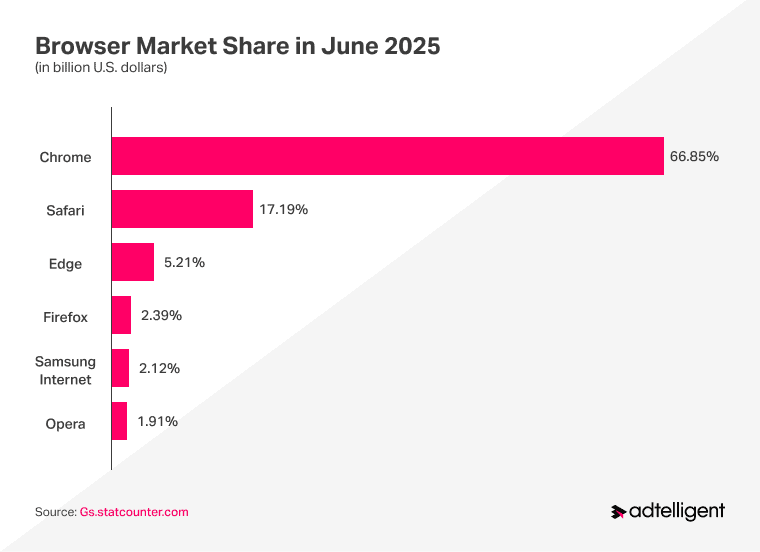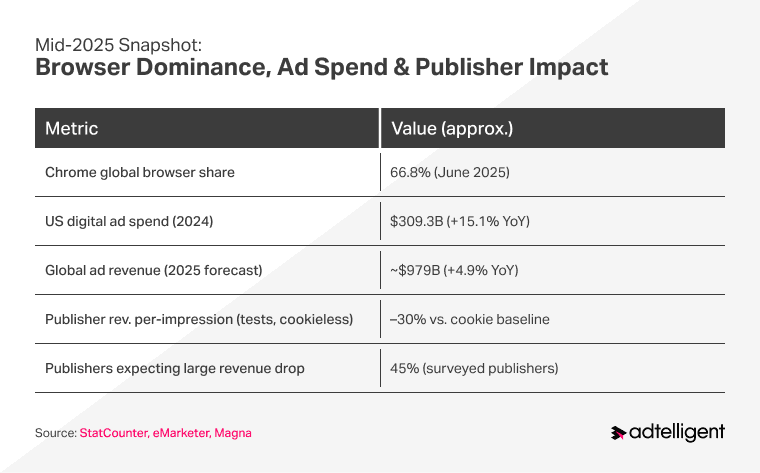Last years, everyone in the digital advertising industry was getting ready for the third-party cookies to phase out. However, in 2025 Google suddenly announced it will continue to support third-party cookies indefinitely.
The original timeline (announced in 2020 for completion by 2022) was repeatedly pushed back (first to 2024 and then into 2025). In July 2024 Google announced it would cancel the forced phase-out altogether, instead letting users choose whether to block third-party cookies via Chrome’s settings. This change was reaffirmed in April 2025, when Google said it would not roll out a new cookie-opt-in prompt and would keep third-party cookies enabled by default (users can still manually toggle them in Privacy & Security settings).
In practice, third-party cookies currently remain usable in Chrome until further notice, as Google continues to refine alternate privacy controls (e.g. the upcoming “IP Protection” in Incognito) rather than imposing a firm deprecation date.
Table of Contents
Why Did Google Chrome Wanted to Get Rid of Third-Party Cookies?
Transparency and data protection have become acute problem on the web. Google announced its Privacy Sandbox with a clear intention to strengthen privacy on the web. The aim is to make browser’s usage more secure for users who in turn demand greater possibilities to control usage of their personal data. Industry observers have also suggested that Google protects its own business as the world’s largest online advertising company, representing 60+% of the global browser market.
Though Google is not the first browser that initiated the anti-tracking approach through cookies blocking. Safari and Firefox have already reduced cross-site tracking by limiting cookies and website data analysis. Apple Safari initiated Intelligent Tracking Prevention (ITP), released in 2017, as a solution to protect user privacy by restricting their data tracking across the web. Mozilla Firefox did the same by launching Enhanced Tracking Protection (ETP).
With Apple’s initiative, the primary challenge has become a short lifetime of cookies that breaches web analytics. Originally user-tracking cookies can last up to 2 years from the date of the first user’s visit. Such a mechanism as ITP is aimed to break user tracking by reducing the lifetime of cookies. Any cookie set by the browser will be deleted after 7 days in ITP 2.1. Cookie set by the browser, if the user came from the cross-domain link, will be deleted after 1 day in ITP 2.2. According to the latest ITP update 2.3, any local storage set when the user comes from a cross-domain link is wiped after 7 days of inactivity. This affects publishers, marketers, and ad tech vendors who rely on third-party cookies to target a niche audience.
Google said they want to institute a mechanism to control who is in charge of an advertisement and who collects the information and for which purposes.
Privacy Sandbox API Adoption
Google’s Privacy Sandbox advertising APIs are now broadly available in Chrome, though industry uptake remains limited. According to Google’s project status pages, the Topics API, Protected Audience API (formerly FLEDGE), and Attribution Reporting API have all moved into general-availability (GA) rollout (enabled by default in recent Chrome releases). For example, Chrome 119+ includes the updated Topics taxonomy and algorithm, and Protected Audience has shipped a raft of bidding and auction features in Q3–Q4 2023 and beyond. Attribution Reporting likewise reached GA status and supports richer conversion configuration as of late 2023.
Chrome is also updating its user interface to reflect the new privacy tools. For example, an “Ad privacy” panel is being tested in Chrome’s settings to give users direct control over Topics, ad personalization, and measurement features. (Google has indicated these controls will replace any standalone cookie prompt.) Despite GA status, real-world adoption is slow. Some reports found only ~32% of digital ad buyers were actively testing Privacy Sandbox tools at scale. Industry sources also note that many publishers and platforms have put large-scale Sandbox experiments on hold pending a clear roadmap. In short, the Privacy Sandbox APIs are available in Chrome Stable, but most advertisers/publishers have not fully shifted over yet.
Key Metrics and Market Impact
Chrome market share: Chrome’s dominance is undiminished. As of May 2025, Chrome held about 66.8% of global browser usage (StatCounter), with Safari (~17%) and Edge (~5%) trailing far behind.

Digital ad spending: Despite the cookie uncertainty, digital ad budgets continue to grow. US programmatic and digital ad spend reached ~$309.3 billion in 2024 (a 15.1% increase over 2023), and Magna forecasts roughly $979 billion in worldwide ad revenues in 2025 (a 4.9% gain). Digital platforms (particularly video and retail media) are powering this growth, even as traditional media declines.
Publisher revenue impact: Independent testing shows big shortfalls without cookies. The UK CMA’s June 2025 report found that per-impression publisher revenue was roughly 30% lower under Privacy Sandbox tools versus normal cookies. Google’s own tests (with only Sandbox enabled) saw similar drops (~27% on Google Ad Manager). Industry forecasts echo this pain: a GroupM analysis warns publishers could lose on the order of 20–30% of ad revenue if replacements don’t match cookies, and surveys show 45% of publishers expect a “significant” revenue decline when cookies vanish. (These figures assume Sandbox or other solutions instead of cookies – without any replacement, losses would be even higher.)
What Do Programmatic Parties Think About Chrome’s Initiative?
Surveys and reports paint a picture of uneven readiness and mixed confidence:
Adoption shifts: IAB’s State of Data (2024) found nearly 90% of marketers report shifting their personalization tactics, budget allocation, and data mix (favoring first- and zero-party data) in anticipation of privacy changes. Similarly, Adobe’s 2024 marketer survey shows brands using cookies less: only 49% say cookies are “essential” to their strategy (down from 75% in 2022), though 28% still spend ≥50% of budget on cookie-based targeting.
Preparedness: Despite these efforts, many companies feel underprepared. Adobe found only 60% of brands feel “mostly” or “very” prepared for cookie loss (versus 78% in 2022). A March 2025 Deloitte survey was even starker: only ~15% of global marketers felt fully ready for a cookieless world. On the bright side, over half of U.S. marketers reported increasing investment in first-party data collection during 2024.
Sandbox trials: Early tests of the Privacy Sandbox are proceeding slowly. In early 2025 only ~32% of programmatic buyers reported actually using Sandbox APIs in campaigns. Some industry voices note that testing remains fragmented and performance (e.g. CPMs, audience reach) is “working but lower” until broad adoption occurs.
Publisher sentiment: Industry outlook is cautious. According to Digiday+ research, publishers were ready to move to first-party data even before the news about saving third-party cookies in Chrome.
In Q1 2025, 71% of publishers recognized first-party data as a key source of positive advertising results (in 2024, this was 64%). 85% expect the role of first-party data in monetization to increase even more in 2026, while the importance of third-party data is rapidly declining.

In summary, while privacy-first strategies (first-party data, contextual ads, clean rooms, etc.) are gaining traction, the consensus in mid-2025 is that the ecosystem is still adapting. Many advertisers and publishers are using the extra time (courtesy of Google’s delays) to test alternatives and build new capabilities, but large-scale deployment of fully cookieless ad solutions is not yet complete. Organizations are taking note of regulatory findings and survey insights as they refine their strategies for a future where cookies are less central.
FAQ On 3rd-Party Cookies
What Is Cookie?
A cookie is a piece of information sent from the web-server to the web browser that saves the user’s data and then sends it back with each request made to the server when the user visits the website. While sending a request, the browser checks if the properties, domain, path, and secure match the website’s data that was requested initially. If the information lines up, the browser sends the relevant cookies together with the request.
What Are Third Party Cookies and First Party Cookies?
What are third-party cookies compared to first-party? Both these cookies are data files that the web browser saves to the user’s computer. First-party cookies store login details, website configuration, and information about added products to the shopping cart. Through third-party cookies, advertising companies and social networks can carry out behavioral targeting, ad tracking, and measurement for deep analytics. The core difference between the first-party and third-party cookies lies in the domain that creates the cookies and saves them primarily. The website that user visits directly creates and stores first-party cookies. Other sites of the publishers’ partners and advertising services set up and gather third-party cookies to use them for remarketing purposes.
What Is the Role of 3P Cookies for Programmatic Advertising?
Third-party cookies have been the base for programmatic advertising intended for ad serving and cross-site tracking since 1994. Here are the main functions of 3P cookies:
– personalized ad targeting;
– cross-site retargeting;
– social buttons posting;
– third-party services placing (such as chatbot);
– impressions measuring to user actions;
detailed analysis.
The cookies technology enables publishers and ad buyers to show relevant advertising to specific users and get impressions that have been valuable assets in programmatic.